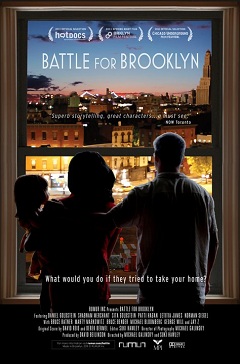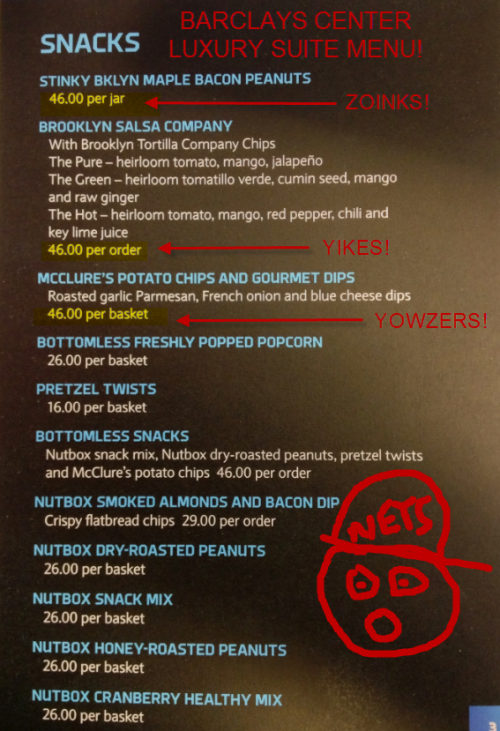The story behind Atlantic Yards, via the 2011 documentary Battle for Brooklyn is now available as a DVD and download.
It's unchanged in narrative--it ends essentially with the groundbreaking and arena in mid-construction. The movie is thus dated--the arena itself is now a juggernaut for publicity and a residential building, long delayed, is finally under way. Some statistics need an update.
Still, as I wrote in my review, it's "most valuable in the camera’s witness to the palpable insincerity and cold-blooded indifference of the developer-government alliance."
The addendum--an interview with the filmmakers (Michael Galinsky, Suki Hawley, David Beilinson), and protagonist Daniel Goldstein--offers worthy perspective. Hawley points out that, however much people cheer the arena, they know "something happened that wasn't quite right."
Indeed. Sure, arena-related traffic isn't as bad as feared, nor is there much crime, though the Times still soft-pedaled the impacts yesterday.
But the controversy will continue, so the story in Battle, and the skepticism it provokes, should endure.
After all, didn't developer Forest City Ratner get away with lying to City Council last month about whether their steel subcontractor was a union shop? Doesn't Forest City continue to say, with impunity, that it has no plans to hire the Independent Compliance Monitor promised as part of the Community Benefits Agreement (CBA)?
And didn't Brooklyn United for Innovative Local Development (BUILD), the Community Benefits Agreement signatory that was criticized in the film, close in November in the wake of funding troubles and tax arrears?
And what about that arena as sub-woofer, barely mentioned in the Times??
A Markowitz review
The movie got mostly good reviews, and the DVD box I have quotes the Daily News critic: "The movie has heart, soul, and chutzpah."
I don't think I'd seen a quote from Borough President Marty Markowitz until I found one in the 4/27/12 Forward:
It's unchanged in narrative--it ends essentially with the groundbreaking and arena in mid-construction. The movie is thus dated--the arena itself is now a juggernaut for publicity and a residential building, long delayed, is finally under way. Some statistics need an update.
Still, as I wrote in my review, it's "most valuable in the camera’s witness to the palpable insincerity and cold-blooded indifference of the developer-government alliance."
The addendum--an interview with the filmmakers (Michael Galinsky, Suki Hawley, David Beilinson), and protagonist Daniel Goldstein--offers worthy perspective. Hawley points out that, however much people cheer the arena, they know "something happened that wasn't quite right."
Indeed. Sure, arena-related traffic isn't as bad as feared, nor is there much crime, though the Times still soft-pedaled the impacts yesterday.
But the controversy will continue, so the story in Battle, and the skepticism it provokes, should endure.
After all, didn't developer Forest City Ratner get away with lying to City Council last month about whether their steel subcontractor was a union shop? Doesn't Forest City continue to say, with impunity, that it has no plans to hire the Independent Compliance Monitor promised as part of the Community Benefits Agreement (CBA)?
And didn't Brooklyn United for Innovative Local Development (BUILD), the Community Benefits Agreement signatory that was criticized in the film, close in November in the wake of funding troubles and tax arrears?
And what about that arena as sub-woofer, barely mentioned in the Times??
A Markowitz review
The movie got mostly good reviews, and the DVD box I have quotes the Daily News critic: "The movie has heart, soul, and chutzpah."
I don't think I'd seen a quote from Borough President Marty Markowitz until I found one in the 4/27/12 Forward:
“The documentary is pure propaganda and produced by filmmakers who have an agenda and are obviously opposed to the project,” he told the Forward. “No other single decision could have had as significant an impact on economic development in this area. The Nets will be the first professional sports team in Brooklyn since our beloved Dodgers left in 1957.”Wow, a charge of "pure propaganda" from an elected official who claimed that "Brooklyn is 1000 percent behind Atlantic Yards"?
After all, hasn't the developer spent a lot more money on public relations, lobbying, and political contributions, which might add up to "propaganda"?
While the documentary is less balanced than C-SPAN, that doesn't make it propaganda. It means there's a point of view, based on reporting and analysis.
And it's a reminder that, however Markowitz cheers "his" beloved Brooklyn Nets, the government and media have not done their job--as I say in the film--to evaluate the promises and process behind Atlantic Yards. It was never a fair fight.






